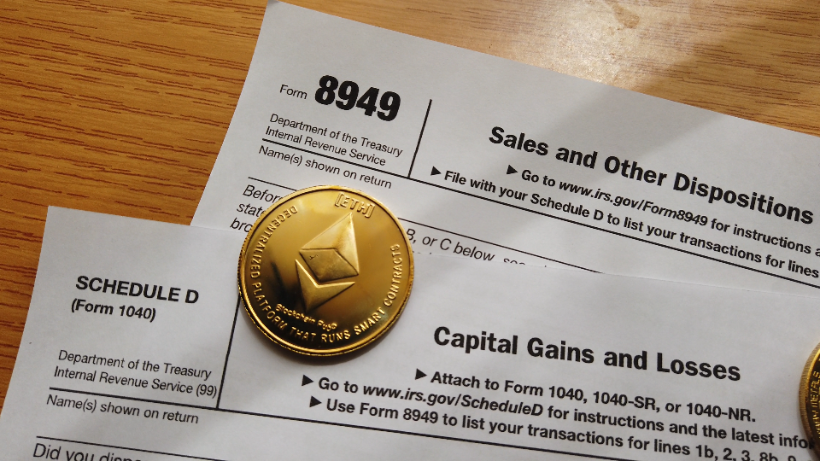
Think of this sheet as your score card for playing Monopoly, but with real money.
When it comes to reporting sales, capital gains, and capital losses on your tax return, Internal Revenue Service Tax Form 8949 is the go-to form. This form is designed to help individual taxpayers accurately report their investment transactions and ensure the correct basis, sales price, and type of gain or loss are reported.
If you’ve sold any capital assets during the year, such as stocks, bonds, mutual funds, or real estate, you may have several eligible gains, whether long-term or short-term gains. So you’ll need to use tax form 8949 to report the sale of capital assets. This form is used to report both long-term transactions (held for more than a year) and short-term transactions (held for a year or less).
Form 8949 is divided into multiple categories, each with specific information to be filled out. You’ll need to provide a description of the property, the purchase or acquisition date, the sale or disposition date, the proceeds from the sale, and the cost or other basis in each column. Additionally, there are adjustment codes that may need to be included in the appropriate column.
While some taxpayers may be able to complete Schedule D without using Form 8949, it is important to note that for those who need to report multiple sales or report sales of different types of capital assets, Form 8949 is required.
By following the form instructions and accurately reporting your sales, capital gains, and capital losses, you can ensure compliance with tax laws and avoid any potential penalties.
Who Uses Form 8949 and to Do What?
Form 8949 is an essential document used by individual taxpayers to report their investment transactions to the IRS. The purpose is to provide detailed information about the sale or disposition of capital assets, such as stocks, bonds, mutual funds, or real estate.
Any taxpayer who has engaged in these types of investment transactions throughout the year must use Form 8949 to report them accurately. This form is particularly important for individuals who need to report multiple sales or sales of different types of capital assets.
By using Form 8949, taxpayers can categorize their transactions based on whether they are long-term (held for more than a year) or short-term (held for a year or less). It allows individuals to report the relevant details, such as the description of the property, purchase or acquisition date, sale or disposition date, proceeds from the sale, and the cost or other basis.
The target audience for Form 8949 is individual taxpayers who have engaged in capital asset transactions and need to accurately report them on their tax returns. By using this form, taxpayers can ensure compliance with IRS regulations while accurately reporting their investment activities.
Which Transactions Do I Report on Form 8949?
When it comes to reporting investment transactions on your taxes, Form 8949 is an essential tool. This form is necessary for individuals who have engaged in various types of investment activities throughout the year. But which transactions exactly should be reported on Form 8949?
Form 8949 is designed to report sales or disposals of capital assets that produce either a capital gain or a capital loss. This includes a wide range of investment transactions such as stocks, bonds, mutual funds, and options trading. It’s important to accurately report each of these transactions to ensure compliance with tax laws.
However, there are some exceptions where it’s not required. These exceptions include transactions that do not result in a capital gain or loss, such as the sale of personal property. Additionally, transactions that are already reported on other forms, like the 1099-B form for stock sales, may not need to be reported again on Form 8949.
To accurately report your investment transactions, it’s crucial to carefully review the instructions and guidelines provided by the IRS. By understanding which types of transactions should be reported on Form 8949, you can ensure that you are properly meeting your tax obligations. Remember, accurate reporting is key to avoiding any potential penalties or audits.
In conclusion, Form 8949 is used to report a variety of investment transactions, including stocks, bonds, mutual funds, and options trading. However, there are exceptions where this form may not be required. To ensure compliance with tax laws, it’s important to review the instructions for form 8489 and accurately report all relevant investment transactions.
What Forms Do I Need Before I can Start Filling out Form 8949?
Before you can start filling out Form 8949, it is important to gather and review several necessary forms. The first form you need to obtain is Form 1099-B, which you receive from your broker or financial institution because you’re an actual owner or a nominee for owner. This form provides information about your capital asset transactions, including the sales price and whether it resulted in a short-term or long-term gain.
In some cases, your broker may provide a substitute statement instead of Form 1099-B. This statement should contain the same information as Form 1099-B and can be used in place of the official form.
It is crucial to review the basis reported to the IRS on Form 1099-B or the substitute statement. If you notice any errors or discrepancies, you need to make a correction or adjustment on Form 8949. Additionally, if you meet Exception 1, which applies to transactions for which the basis was not reported to the IRS, you need to attach a separate statement explaining the basis of each transaction.
By gathering and carefully reviewing these necessary forms, you can ensure that the information you provide on Form 8949 is accurate and complete. This will help you correctly report your short-term and long-term capital gains and loss transactions, as well as avoid any potential issues with your tax return.
The Categories on IRS Form 8949 Explained
When filling out IRS Form 8949 to report your investment transactions, you will come across three categories for both short-term and long-term transactions. These categories are essential in accurately reporting your gains or losses and determining the correct tax implications.
For short-term transactions, you will find categories A, B, and C on Form 8949. Category A is for transactions where you received a 1099-B or a substitute statement showing the cost basis was reported to the IRS. Category B is for transactions where the cost basis was not reported to the IRS, requiring you to adjust the reported basis by using codes provided in the instructions. Finally, Category C is for transactions that are not reported on Form 1099-B, such as the sale of property held for personal use, and require you to report the details for each transaction.
Similarly, there are categories D, E, and F for long-term transactions on Form 8949. Category D is for transactions where you received a 1099-B or a substitute statement showing the cost basis was reported to the IRS. Category E is for transactions where the cost basis was not reported to the IRS and you need to adjust the reported basis using the provided codes. Lastly, Category F is for transactions not reported on Form 1099-B and requires you to provide information regarding each. You should file a separate Form 8949 for each category of transactions.
How to Fill out Form 8949, Column by Column
When it comes to filling out Form 8949, you have two parts to fill out after putting your social security or taxpayer identification down. Part I refers to short-term assets and gains, and then part II refers to long-term gains and losses. Both lists give you a way to track exchanges of capital assets over the year and put a final calculation of short- and long-term capital gains on your individual or joint return.
Several columns add descriptors to each sale transaction. Let’s go through each column and understand what needs to be included.
First, in the “Description of Property” column, provide a brief description of the asset or property that was sold or disposed of. This could include stocks, bonds, mutual funds, or other types of investments. The IRS sees thousands of transactions including business stock, money market, or installment sales.
Put down when you got the property in the “Date Acquired” column. This is important for determining whether the transaction is considered a long-term or short-term capital gain or loss.
Then, enter the exact date you sold it in the “Date Sold or Disposed Of” column. Be sure to accurately record the date to determine the holding period and the type of gain or loss.
Moving on to the “Proceeds” column, enter the sales price or the amount of money you received from selling the property. This should reflect the actual proceeds you received, not the sales price. Exclude any fees or commissions.
In the “Cost Basis” column, you need to enter the correct basis in column E . This is the original purchase price of the asset, including any transaction fees or expenses associated with acquiring it. If the basis was not reported to the IRS, you may need to refer to the instructions for adjustment codes to calculate the correct basis.
Lastly, in the “Adjustment to Gain or Loss” column, any adjustments to the gain or loss of the transaction should be entered using the appropriate adjustment codes provided in the instructions. This adjustment in column G could represent adjustments for wash sales, like-kind exchanges, or other special circumstances. Mark gains with parentheses as negative adjustments, and losses as positive adjustments.
What Is a Wash Sale?
When it comes to reporting your capital asset transactions on Form 8949, it is crucial to understand what a wash sale is and how it impacts your tax return. A wash sale occurs when you sell or dispose of a stock, security, or mutual fund at a loss and within 30 days before or after the sale, you acquire a substantially identical security.
Properly reporting a wash sale is essential because the loss from the sale is considered a nondeductible loss, meaning you cannot claim it as a deduction on your taxes. Instead, you must adjust the basis of your newly acquired security by the disallowed loss amount. This adjustment is necessary to ensure the correct basis is used when calculating future gains or losses on the sale of that security.
To accurately report a wash sale, refer to the IRS guidelines provided in the Schedule D instructions or IRS Publication 550. These resources offer detailed information on how to handle wash sales and the specific reporting requirements. Remember, failing to report a wash sale correctly can result in incorrect basis calculations, which may lead to inaccuracies in your tax return.
What Are Some Examples of Special Circumstances for Form 8949?
When it comes to reporting your capital asset transactions on your tax return, you may find yourself in some special circumstances that require the use of Form 8949. This form is used by individual taxpayers to report their sales, exchanges, and other dispositions of capital assets.
One example of a special circumstance that would necessitate the use of Form 8949 is if you have engaged in currency trading. Currency trading falls under the category of section 1256 contracts, which are regulated differently from regular capital assets. In this case, you would need to report your gains or losses from currency trading on Form 8949, rather than on Schedule D.
Another special circumstance is if you have engaged in wash sales. A wash sale occurs when you sell an investment at a loss and then repurchase the same or substantially identical investment within 30 days before or after the sale. In this situation, you would need to report the details of the wash sale on Form 8949 separately, rather than combining it with your regular sales.
What Do the Various Adjustment Codes Mean?
When filing your tax return and reporting your capital asset transactions on Form 8949, you may come across various adjustment codes. It’s essential to understand what these adjustment codes mean and how they affect your taxes. Here’s a breakdown of the most commonly used adjustment codes on Form 8949:
– Code A: Corrected basis. Use this code if you need to adjust the cost basis of your asset due to an error on the original Form 1099-B or if additional information becomes available after filing.
Example: You mistakenly entered the wrong purchase price for a stock, and now need to correct the basis.
– Code B: Basis reported to IRS. This code indicates that the basis of the asset has already been reported to the IRS on a separate form, such as Form 1099-B.
Example: You received a statement from your financial institution reporting the basis of your mutual fund transactions.
– Code D: Noncovered security. This code is used for assets acquired before January 1, 2011, or those not subject to cost basis reporting requirements.
Example: You sold shares of a stock that you purchased before 2011.
– Code E: Short-term gain reported on 1099-B but not reported to the IRS. This code applies when the cost basis reported to the IRS for a short-term transaction is lower than what was reported on Form 1099-B.
Example: Your broker reported a lower cost basis for a short-term stock sale on Form 1099-B, but you believe the basis reported to the IRS is incorrect.
These are just a few examples of the adjustment codes you may encounter on Form 8949. For a complete list and detailed instructions, refer to the IRS website or consult a tax professional. Remember, accurately reporting your capital asset transactions ensures you comply with tax regulations and avoid any potential penalties.
How Do I Report a 1061 Transaction?
If you’ve engaged in a 1061 transaction, it’s important to understand the requirements and steps involved in reporting it on your tax return. This can be done by using the appropriate form, Form 8949, which is used to report sales and other dispositions of capital assets.
To report a 1061 transaction, you’ll need to identify and recharacterize certain long-term capital gains as short-term capital gains. The IRS provides guidelines for reporting these recharacterization amounts. This is necessary because section 1061 of the Internal Revenue Code affects the tax treatment of gains from certain partnership interests held in connection with the performance of substantial services.
When reporting a 1061 transaction on Form 8949, you’ll need to provide accurate and complete information about the transaction, such as the sale price, purchase price, and description of the property. It’s important to carefully follow the instructions provided by the IRS to ensure that the transaction is reported correctly.
In conclusion, if you’ve engaged in a 1061 transaction, it’s crucial to understand the reporting requirements and steps involved. By using Form 8949 and following the IRS guidelines, you can accurately report the transaction on your tax return. This step is crucial for properly calculating your long-term capital gains or losses.
Could I Skip Form 8949 and Turn in Schedule D Itself?
If you have capital gains or losses to report on your tax return, then the answer is no. Form 8949 is an essential component that cannot be skipped when completing Schedule D.
Form 8949 provides a detailed list of your capital asset transactions, including the description of property, date acquired, date sold or disposed of, proceeds, cost basis, and any adjustments to the gain or loss. These details are crucial for accurately calculating your total gain or loss from these transactions.
Without Form 8949, you would not have the necessary information needed to report your capital gains and losses on Schedule D. This form ensures that you report each transaction correctly and calculate your gains or losses accurately.
Once you have completed Form 8949 and calculated the totals for your capital gains and losses, these totals are then transferred to Schedule D. Schedule D is where you sum up all your capital gains and losses for the tax year and determine the amount of capital gains taxes owed.
So, it’s clear that Form 8949 is an integral part of accurately reporting and calculating your capital gains or losses. Make sure to complete it in detail and attach it to your tax return to avoid any issues.

Sarah Nieschalk
Sarah E. Deierlein Nieschalk, EA, is an experienced tax professional with over a decade of expertise representing taxpayers before the IRS. As an Enrolled Agent and Assistant Vice President of Servicing at Community Tax, LLC, Sarah specializes in resolving complex federal and state tax collection issues, including high-dollar individual liabilities, employment tax challenges, and corporate audits. Since becoming an Enrolled Agent in 2012, she has resolved over 5,000 cases, saving millions for clients while protecting countless businesses. Outside of work, Sarah enjoys painting, staying active, and raising her family of rescued dogs while contributing to nonprofit causes through storytelling events.







